Marketing in Hospitality (Unit 8): McDonald's Marketing Report
VerifiedAdded on 2023/03/24
|12
|4139
|23
Report
AI Summary
This report delves into the concepts of marketing within the hospitality industry, using McDonald's as a primary case study. It begins with an introduction to marketing concepts, emphasizing the importance of understanding consumer demands and developing effective strategies for profitability. The report explores the impact of the marketing environment, including trends, competition, political factors, and economic conditions, on the industry. It examines the relevance of consumer markets, detailing demographic, psychographic, behavioral, and geographic characteristics. Furthermore, the report analyzes market segmentation, outlining the reasons for its development and its benefits for businesses. The importance of marketing mix components (product, price, promotion, and place) is discussed, along with pricing strategies and the implementation of marketing plans. The report concludes with a summary of key findings and references.

Marketing in
Hospitality
1
Hospitality
1
Paraphrase This Document
Need a fresh take? Get an instant paraphrase of this document with our AI Paraphraser
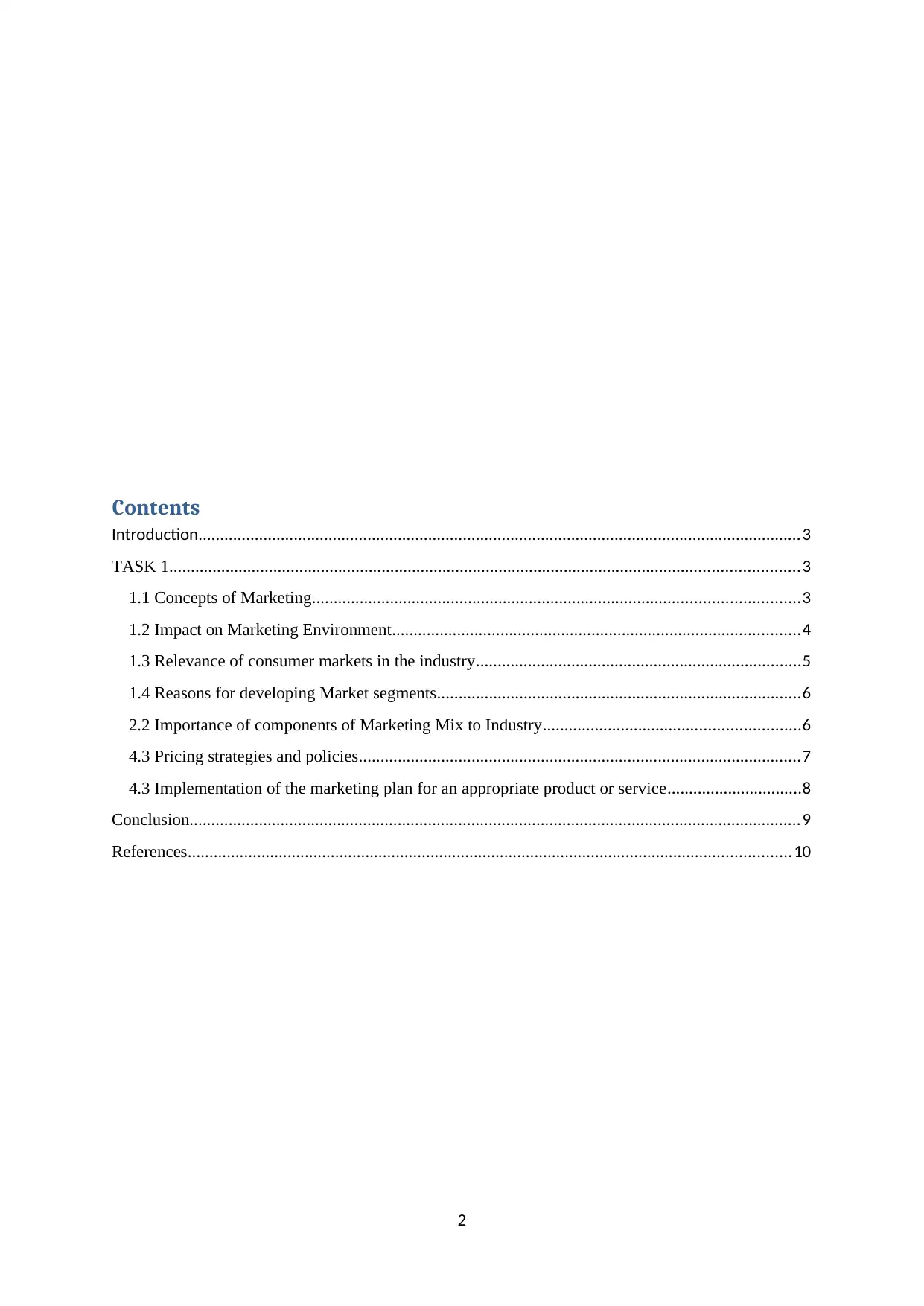
Contents
Introduction...........................................................................................................................................3
TASK 1.................................................................................................................................................3
1.1 Concepts of Marketing................................................................................................................3
1.2 Impact on Marketing Environment..............................................................................................4
1.3 Relevance of consumer markets in the industry...........................................................................5
1.4 Reasons for developing Market segments....................................................................................6
2.2 Importance of components of Marketing Mix to Industry...........................................................6
4.3 Pricing strategies and policies......................................................................................................7
4.3 Implementation of the marketing plan for an appropriate product or service...............................8
Conclusion.............................................................................................................................................9
References...........................................................................................................................................10
2
Introduction...........................................................................................................................................3
TASK 1.................................................................................................................................................3
1.1 Concepts of Marketing................................................................................................................3
1.2 Impact on Marketing Environment..............................................................................................4
1.3 Relevance of consumer markets in the industry...........................................................................5
1.4 Reasons for developing Market segments....................................................................................6
2.2 Importance of components of Marketing Mix to Industry...........................................................6
4.3 Pricing strategies and policies......................................................................................................7
4.3 Implementation of the marketing plan for an appropriate product or service...............................8
Conclusion.............................................................................................................................................9
References...........................................................................................................................................10
2
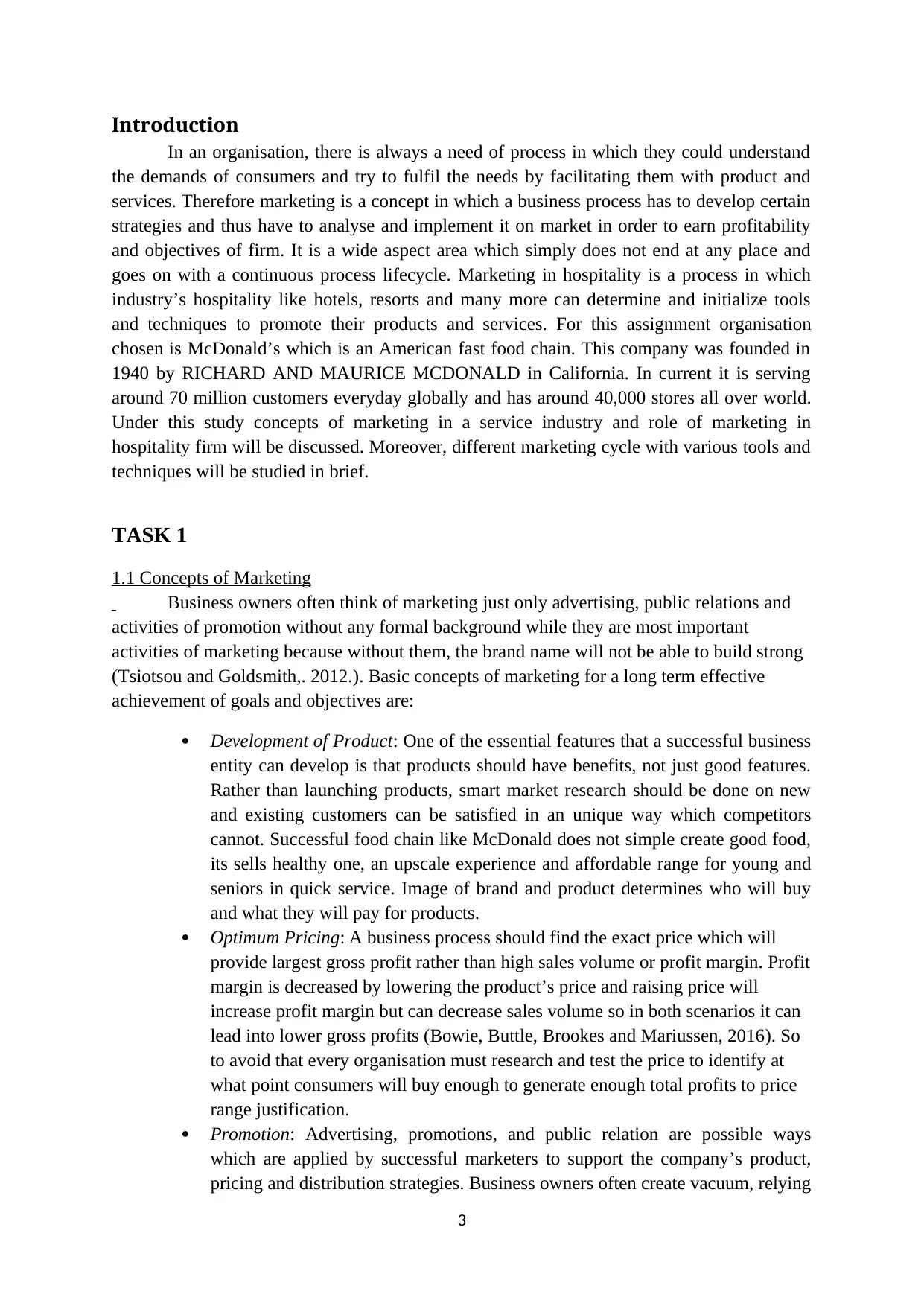
Introduction
In an organisation, there is always a need of process in which they could understand
the demands of consumers and try to fulfil the needs by facilitating them with product and
services. Therefore marketing is a concept in which a business process has to develop certain
strategies and thus have to analyse and implement it on market in order to earn profitability
and objectives of firm. It is a wide aspect area which simply does not end at any place and
goes on with a continuous process lifecycle. Marketing in hospitality is a process in which
industry’s hospitality like hotels, resorts and many more can determine and initialize tools
and techniques to promote their products and services. For this assignment organisation
chosen is McDonald’s which is an American fast food chain. This company was founded in
1940 by RICHARD AND MAURICE MCDONALD in California. In current it is serving
around 70 million customers everyday globally and has around 40,000 stores all over world.
Under this study concepts of marketing in a service industry and role of marketing in
hospitality firm will be discussed. Moreover, different marketing cycle with various tools and
techniques will be studied in brief.
TASK 1
1.1 Concepts of Marketing
Business owners often think of marketing just only advertising, public relations and
activities of promotion without any formal background while they are most important
activities of marketing because without them, the brand name will not be able to build strong
(Tsiotsou and Goldsmith,. 2012.). Basic concepts of marketing for a long term effective
achievement of goals and objectives are:
Development of Product: One of the essential features that a successful business
entity can develop is that products should have benefits, not just good features.
Rather than launching products, smart market research should be done on new
and existing customers can be satisfied in an unique way which competitors
cannot. Successful food chain like McDonald does not simple create good food,
its sells healthy one, an upscale experience and affordable range for young and
seniors in quick service. Image of brand and product determines who will buy
and what they will pay for products.
Optimum Pricing: A business process should find the exact price which will
provide largest gross profit rather than high sales volume or profit margin. Profit
margin is decreased by lowering the product’s price and raising price will
increase profit margin but can decrease sales volume so in both scenarios it can
lead into lower gross profits (Bowie, Buttle, Brookes and Mariussen, 2016). So
to avoid that every organisation must research and test the price to identify at
what point consumers will buy enough to generate enough total profits to price
range justification.
Promotion: Advertising, promotions, and public relation are possible ways
which are applied by successful marketers to support the company’s product,
pricing and distribution strategies. Business owners often create vacuum, relying
3
In an organisation, there is always a need of process in which they could understand
the demands of consumers and try to fulfil the needs by facilitating them with product and
services. Therefore marketing is a concept in which a business process has to develop certain
strategies and thus have to analyse and implement it on market in order to earn profitability
and objectives of firm. It is a wide aspect area which simply does not end at any place and
goes on with a continuous process lifecycle. Marketing in hospitality is a process in which
industry’s hospitality like hotels, resorts and many more can determine and initialize tools
and techniques to promote their products and services. For this assignment organisation
chosen is McDonald’s which is an American fast food chain. This company was founded in
1940 by RICHARD AND MAURICE MCDONALD in California. In current it is serving
around 70 million customers everyday globally and has around 40,000 stores all over world.
Under this study concepts of marketing in a service industry and role of marketing in
hospitality firm will be discussed. Moreover, different marketing cycle with various tools and
techniques will be studied in brief.
TASK 1
1.1 Concepts of Marketing
Business owners often think of marketing just only advertising, public relations and
activities of promotion without any formal background while they are most important
activities of marketing because without them, the brand name will not be able to build strong
(Tsiotsou and Goldsmith,. 2012.). Basic concepts of marketing for a long term effective
achievement of goals and objectives are:
Development of Product: One of the essential features that a successful business
entity can develop is that products should have benefits, not just good features.
Rather than launching products, smart market research should be done on new
and existing customers can be satisfied in an unique way which competitors
cannot. Successful food chain like McDonald does not simple create good food,
its sells healthy one, an upscale experience and affordable range for young and
seniors in quick service. Image of brand and product determines who will buy
and what they will pay for products.
Optimum Pricing: A business process should find the exact price which will
provide largest gross profit rather than high sales volume or profit margin. Profit
margin is decreased by lowering the product’s price and raising price will
increase profit margin but can decrease sales volume so in both scenarios it can
lead into lower gross profits (Bowie, Buttle, Brookes and Mariussen, 2016). So
to avoid that every organisation must research and test the price to identify at
what point consumers will buy enough to generate enough total profits to price
range justification.
Promotion: Advertising, promotions, and public relation are possible ways
which are applied by successful marketers to support the company’s product,
pricing and distribution strategies. Business owners often create vacuum, relying
3
⊘ This is a preview!⊘
Do you want full access?
Subscribe today to unlock all pages.

Trusted by 1+ million students worldwide
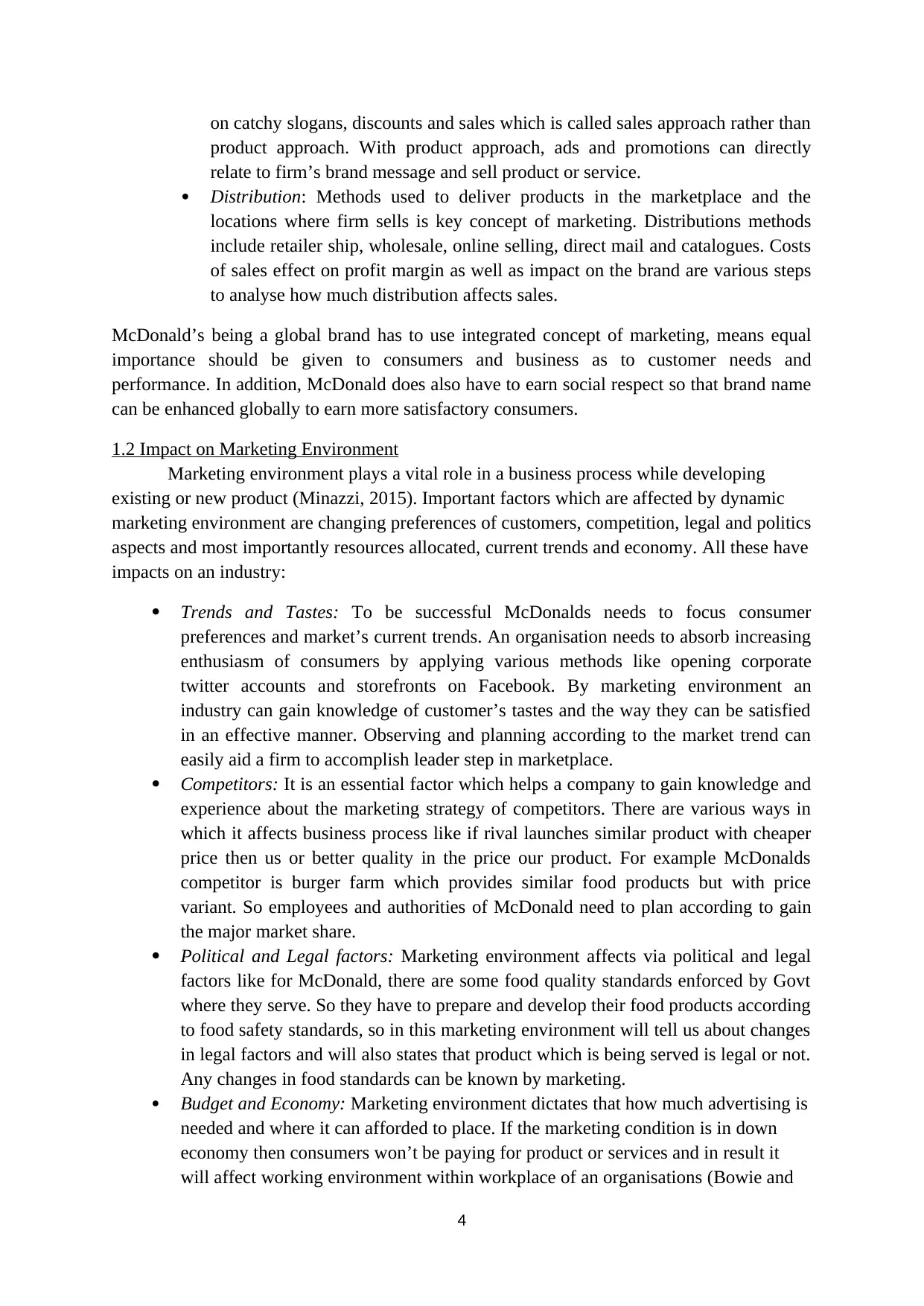
on catchy slogans, discounts and sales which is called sales approach rather than
product approach. With product approach, ads and promotions can directly
relate to firm’s brand message and sell product or service.
Distribution: Methods used to deliver products in the marketplace and the
locations where firm sells is key concept of marketing. Distributions methods
include retailer ship, wholesale, online selling, direct mail and catalogues. Costs
of sales effect on profit margin as well as impact on the brand are various steps
to analyse how much distribution affects sales.
McDonald’s being a global brand has to use integrated concept of marketing, means equal
importance should be given to consumers and business as to customer needs and
performance. In addition, McDonald does also have to earn social respect so that brand name
can be enhanced globally to earn more satisfactory consumers.
1.2 Impact on Marketing Environment
Marketing environment plays a vital role in a business process while developing
existing or new product (Minazzi, 2015). Important factors which are affected by dynamic
marketing environment are changing preferences of customers, competition, legal and politics
aspects and most importantly resources allocated, current trends and economy. All these have
impacts on an industry:
Trends and Tastes: To be successful McDonalds needs to focus consumer
preferences and market’s current trends. An organisation needs to absorb increasing
enthusiasm of consumers by applying various methods like opening corporate
twitter accounts and storefronts on Facebook. By marketing environment an
industry can gain knowledge of customer’s tastes and the way they can be satisfied
in an effective manner. Observing and planning according to the market trend can
easily aid a firm to accomplish leader step in marketplace.
Competitors: It is an essential factor which helps a company to gain knowledge and
experience about the marketing strategy of competitors. There are various ways in
which it affects business process like if rival launches similar product with cheaper
price then us or better quality in the price our product. For example McDonalds
competitor is burger farm which provides similar food products but with price
variant. So employees and authorities of McDonald need to plan according to gain
the major market share.
Political and Legal factors: Marketing environment affects via political and legal
factors like for McDonald, there are some food quality standards enforced by Govt
where they serve. So they have to prepare and develop their food products according
to food safety standards, so in this marketing environment will tell us about changes
in legal factors and will also states that product which is being served is legal or not.
Any changes in food standards can be known by marketing.
Budget and Economy: Marketing environment dictates that how much advertising is
needed and where it can afforded to place. If the marketing condition is in down
economy then consumers won’t be paying for product or services and in result it
will affect working environment within workplace of an organisations (Bowie and
4
product approach. With product approach, ads and promotions can directly
relate to firm’s brand message and sell product or service.
Distribution: Methods used to deliver products in the marketplace and the
locations where firm sells is key concept of marketing. Distributions methods
include retailer ship, wholesale, online selling, direct mail and catalogues. Costs
of sales effect on profit margin as well as impact on the brand are various steps
to analyse how much distribution affects sales.
McDonald’s being a global brand has to use integrated concept of marketing, means equal
importance should be given to consumers and business as to customer needs and
performance. In addition, McDonald does also have to earn social respect so that brand name
can be enhanced globally to earn more satisfactory consumers.
1.2 Impact on Marketing Environment
Marketing environment plays a vital role in a business process while developing
existing or new product (Minazzi, 2015). Important factors which are affected by dynamic
marketing environment are changing preferences of customers, competition, legal and politics
aspects and most importantly resources allocated, current trends and economy. All these have
impacts on an industry:
Trends and Tastes: To be successful McDonalds needs to focus consumer
preferences and market’s current trends. An organisation needs to absorb increasing
enthusiasm of consumers by applying various methods like opening corporate
twitter accounts and storefronts on Facebook. By marketing environment an
industry can gain knowledge of customer’s tastes and the way they can be satisfied
in an effective manner. Observing and planning according to the market trend can
easily aid a firm to accomplish leader step in marketplace.
Competitors: It is an essential factor which helps a company to gain knowledge and
experience about the marketing strategy of competitors. There are various ways in
which it affects business process like if rival launches similar product with cheaper
price then us or better quality in the price our product. For example McDonalds
competitor is burger farm which provides similar food products but with price
variant. So employees and authorities of McDonald need to plan according to gain
the major market share.
Political and Legal factors: Marketing environment affects via political and legal
factors like for McDonald, there are some food quality standards enforced by Govt
where they serve. So they have to prepare and develop their food products according
to food safety standards, so in this marketing environment will tell us about changes
in legal factors and will also states that product which is being served is legal or not.
Any changes in food standards can be known by marketing.
Budget and Economy: Marketing environment dictates that how much advertising is
needed and where it can afforded to place. If the marketing condition is in down
economy then consumers won’t be paying for product or services and in result it
will affect working environment within workplace of an organisations (Bowie and
4
Paraphrase This Document
Need a fresh take? Get an instant paraphrase of this document with our AI Paraphraser

Buttle, 2011). Marketing will let a company know the economic condition as well as
if any enhancement is required for product developing. It will also tell that how
much budget needs to be planned for a product or services.
So it can be said that marketing environment has a huge impact not only on an industry but
also on society.
1.3 Relevance of consumer markets in the industry
In an organisation, products and services which are designed for general consumer to
dominate market is stated as Consumer market (Bharwani and Jauhari,, 2013). Basically there
are four sectors of consumer markets like food, consumer products, retail and wholesale
products. Following are characteristics of consumer markets:
Demographic: This comprises of several factors like gender, age, income, education,
ethnic background etc. Organisation determines their customers by these factors and
targets them accordingly. For example: most of world’s generation depends on fast
food and thus McDonald’s is the brand which servers according to the taste and food
environment.
Physiographic: This segment can be defined as the interests, value and beliefs,
activities, opinions and attitudes of the consumers. After performing a deep research
in the UK market on psychographic characteristics of consumers McDonald was
established and now it is serving well to new and existing customers.
Behavioural: Most important part of this sector is brand loyalty, customer’s benefits,
usage of product. It is an essential part of survey for McDonald as well because it can
be known that customers who visits McDonalds most frequently and how much do
they spend time on each visit.
Geographic: This sector is basically is all about size of market, region, density of
population and climate. It studies the crowd of people and their behaviour to study
about new product success rate (Wearne and Morrison, 2013). For example:
McDonald firstly did geographic market search and studied about the crowded place
of students and children. Geographic characteristics will help McDonalds in knowing
size of market.
Consumer market has several relevance for different market sector. Majorly in food supply
chain McDonald, there are four types of customers in McDonalds:
1. A parent with two children is important factor as being parent of two children it is
easy to treat them in McDonald. In UK it is best place for giving children a fun
filled treat.
2. Happy meals are a great concept for children who love fast food as they enjoy
those services and taste.
3. A business customer finds McDonald a appropriate place to eat as it consist of
fast service and food can be eaten while driving car.
4. Teenagers are major percentage customer’s population due to attraction towards
affordable and quality food prices.
5
if any enhancement is required for product developing. It will also tell that how
much budget needs to be planned for a product or services.
So it can be said that marketing environment has a huge impact not only on an industry but
also on society.
1.3 Relevance of consumer markets in the industry
In an organisation, products and services which are designed for general consumer to
dominate market is stated as Consumer market (Bharwani and Jauhari,, 2013). Basically there
are four sectors of consumer markets like food, consumer products, retail and wholesale
products. Following are characteristics of consumer markets:
Demographic: This comprises of several factors like gender, age, income, education,
ethnic background etc. Organisation determines their customers by these factors and
targets them accordingly. For example: most of world’s generation depends on fast
food and thus McDonald’s is the brand which servers according to the taste and food
environment.
Physiographic: This segment can be defined as the interests, value and beliefs,
activities, opinions and attitudes of the consumers. After performing a deep research
in the UK market on psychographic characteristics of consumers McDonald was
established and now it is serving well to new and existing customers.
Behavioural: Most important part of this sector is brand loyalty, customer’s benefits,
usage of product. It is an essential part of survey for McDonald as well because it can
be known that customers who visits McDonalds most frequently and how much do
they spend time on each visit.
Geographic: This sector is basically is all about size of market, region, density of
population and climate. It studies the crowd of people and their behaviour to study
about new product success rate (Wearne and Morrison, 2013). For example:
McDonald firstly did geographic market search and studied about the crowded place
of students and children. Geographic characteristics will help McDonalds in knowing
size of market.
Consumer market has several relevance for different market sector. Majorly in food supply
chain McDonald, there are four types of customers in McDonalds:
1. A parent with two children is important factor as being parent of two children it is
easy to treat them in McDonald. In UK it is best place for giving children a fun
filled treat.
2. Happy meals are a great concept for children who love fast food as they enjoy
those services and taste.
3. A business customer finds McDonald a appropriate place to eat as it consist of
fast service and food can be eaten while driving car.
4. Teenagers are major percentage customer’s population due to attraction towards
affordable and quality food prices.
5
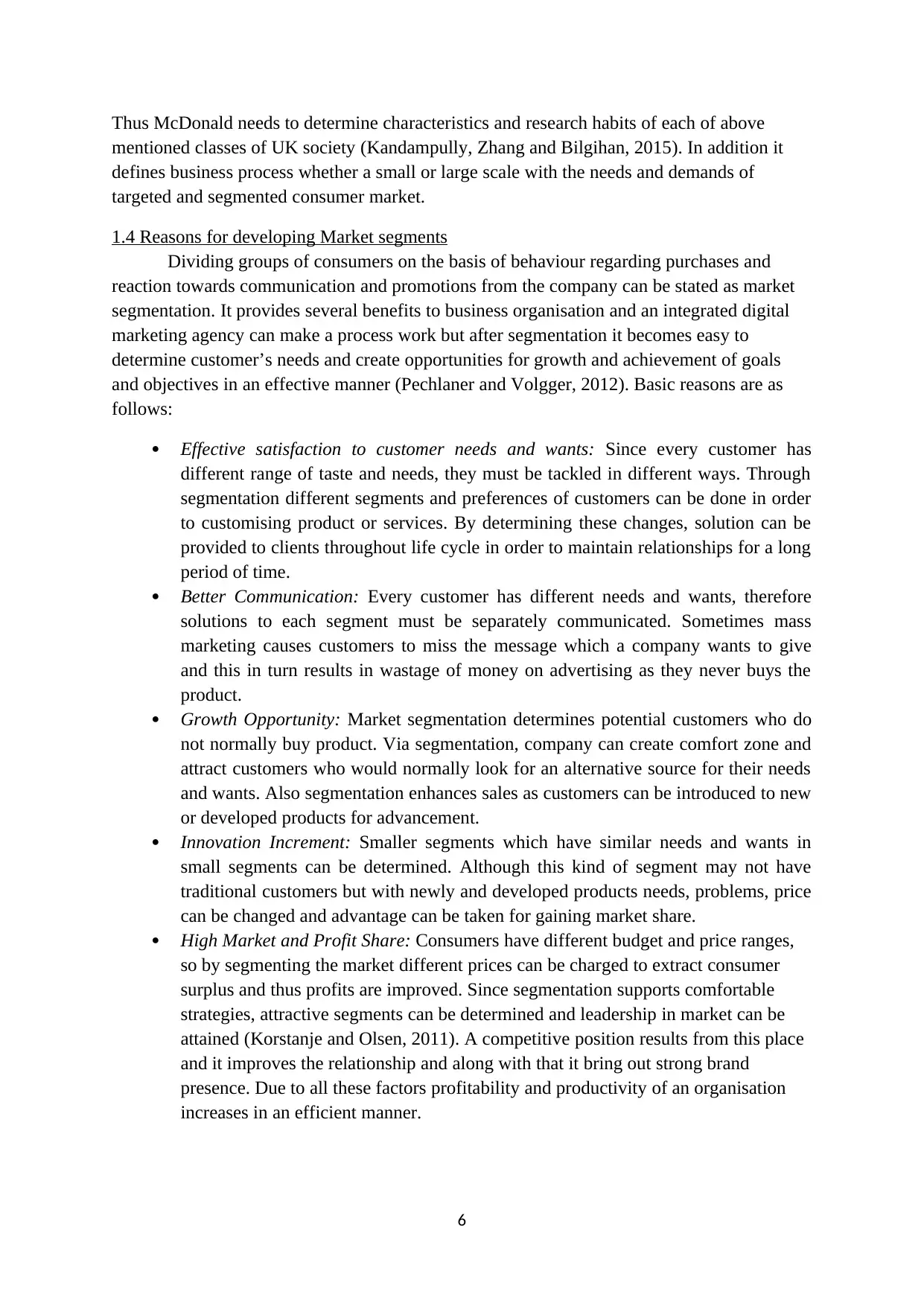
Thus McDonald needs to determine characteristics and research habits of each of above
mentioned classes of UK society (Kandampully, Zhang and Bilgihan, 2015). In addition it
defines business process whether a small or large scale with the needs and demands of
targeted and segmented consumer market.
1.4 Reasons for developing Market segments
Dividing groups of consumers on the basis of behaviour regarding purchases and
reaction towards communication and promotions from the company can be stated as market
segmentation. It provides several benefits to business organisation and an integrated digital
marketing agency can make a process work but after segmentation it becomes easy to
determine customer’s needs and create opportunities for growth and achievement of goals
and objectives in an effective manner (Pechlaner and Volgger, 2012). Basic reasons are as
follows:
Effective satisfaction to customer needs and wants: Since every customer has
different range of taste and needs, they must be tackled in different ways. Through
segmentation different segments and preferences of customers can be done in order
to customising product or services. By determining these changes, solution can be
provided to clients throughout life cycle in order to maintain relationships for a long
period of time.
Better Communication: Every customer has different needs and wants, therefore
solutions to each segment must be separately communicated. Sometimes mass
marketing causes customers to miss the message which a company wants to give
and this in turn results in wastage of money on advertising as they never buys the
product.
Growth Opportunity: Market segmentation determines potential customers who do
not normally buy product. Via segmentation, company can create comfort zone and
attract customers who would normally look for an alternative source for their needs
and wants. Also segmentation enhances sales as customers can be introduced to new
or developed products for advancement.
Innovation Increment: Smaller segments which have similar needs and wants in
small segments can be determined. Although this kind of segment may not have
traditional customers but with newly and developed products needs, problems, price
can be changed and advantage can be taken for gaining market share.
High Market and Profit Share: Consumers have different budget and price ranges,
so by segmenting the market different prices can be charged to extract consumer
surplus and thus profits are improved. Since segmentation supports comfortable
strategies, attractive segments can be determined and leadership in market can be
attained (Korstanje and Olsen, 2011). A competitive position results from this place
and it improves the relationship and along with that it bring out strong brand
presence. Due to all these factors profitability and productivity of an organisation
increases in an efficient manner.
6
mentioned classes of UK society (Kandampully, Zhang and Bilgihan, 2015). In addition it
defines business process whether a small or large scale with the needs and demands of
targeted and segmented consumer market.
1.4 Reasons for developing Market segments
Dividing groups of consumers on the basis of behaviour regarding purchases and
reaction towards communication and promotions from the company can be stated as market
segmentation. It provides several benefits to business organisation and an integrated digital
marketing agency can make a process work but after segmentation it becomes easy to
determine customer’s needs and create opportunities for growth and achievement of goals
and objectives in an effective manner (Pechlaner and Volgger, 2012). Basic reasons are as
follows:
Effective satisfaction to customer needs and wants: Since every customer has
different range of taste and needs, they must be tackled in different ways. Through
segmentation different segments and preferences of customers can be done in order
to customising product or services. By determining these changes, solution can be
provided to clients throughout life cycle in order to maintain relationships for a long
period of time.
Better Communication: Every customer has different needs and wants, therefore
solutions to each segment must be separately communicated. Sometimes mass
marketing causes customers to miss the message which a company wants to give
and this in turn results in wastage of money on advertising as they never buys the
product.
Growth Opportunity: Market segmentation determines potential customers who do
not normally buy product. Via segmentation, company can create comfort zone and
attract customers who would normally look for an alternative source for their needs
and wants. Also segmentation enhances sales as customers can be introduced to new
or developed products for advancement.
Innovation Increment: Smaller segments which have similar needs and wants in
small segments can be determined. Although this kind of segment may not have
traditional customers but with newly and developed products needs, problems, price
can be changed and advantage can be taken for gaining market share.
High Market and Profit Share: Consumers have different budget and price ranges,
so by segmenting the market different prices can be charged to extract consumer
surplus and thus profits are improved. Since segmentation supports comfortable
strategies, attractive segments can be determined and leadership in market can be
attained (Korstanje and Olsen, 2011). A competitive position results from this place
and it improves the relationship and along with that it bring out strong brand
presence. Due to all these factors profitability and productivity of an organisation
increases in an efficient manner.
6
⊘ This is a preview!⊘
Do you want full access?
Subscribe today to unlock all pages.

Trusted by 1+ million students worldwide
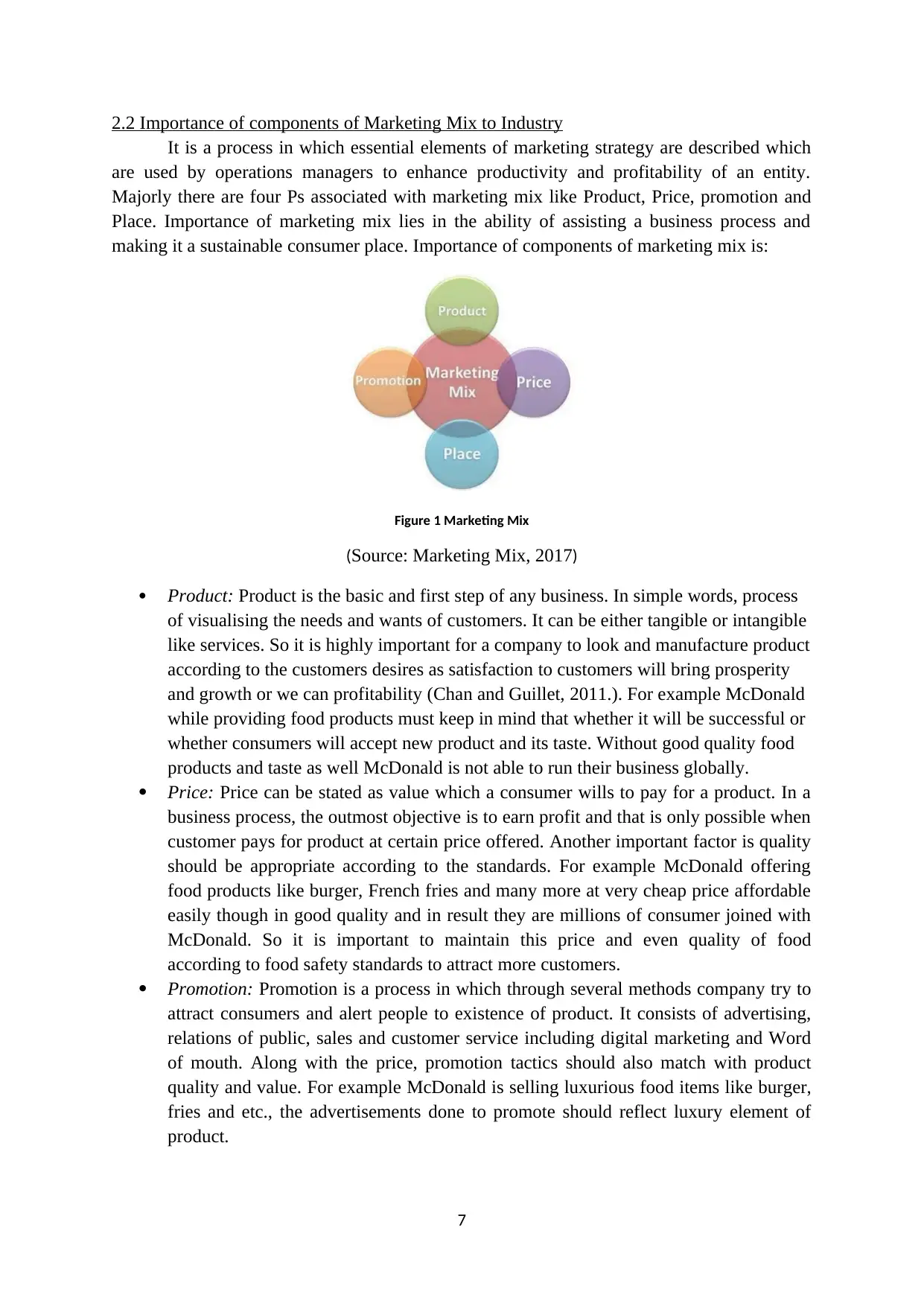
2.2 Importance of components of Marketing Mix to Industry
It is a process in which essential elements of marketing strategy are described which
are used by operations managers to enhance productivity and profitability of an entity.
Majorly there are four Ps associated with marketing mix like Product, Price, promotion and
Place. Importance of marketing mix lies in the ability of assisting a business process and
making it a sustainable consumer place. Importance of components of marketing mix is:
Figure 1 Marketing Mix
(Source: Marketing Mix, 2017)
Product: Product is the basic and first step of any business. In simple words, process
of visualising the needs and wants of customers. It can be either tangible or intangible
like services. So it is highly important for a company to look and manufacture product
according to the customers desires as satisfaction to customers will bring prosperity
and growth or we can profitability (Chan and Guillet, 2011.). For example McDonald
while providing food products must keep in mind that whether it will be successful or
whether consumers will accept new product and its taste. Without good quality food
products and taste as well McDonald is not able to run their business globally.
Price: Price can be stated as value which a consumer wills to pay for a product. In a
business process, the outmost objective is to earn profit and that is only possible when
customer pays for product at certain price offered. Another important factor is quality
should be appropriate according to the standards. For example McDonald offering
food products like burger, French fries and many more at very cheap price affordable
easily though in good quality and in result they are millions of consumer joined with
McDonald. So it is important to maintain this price and even quality of food
according to food safety standards to attract more customers.
Promotion: Promotion is a process in which through several methods company try to
attract consumers and alert people to existence of product. It consists of advertising,
relations of public, sales and customer service including digital marketing and Word
of mouth. Along with the price, promotion tactics should also match with product
quality and value. For example McDonald is selling luxurious food items like burger,
fries and etc., the advertisements done to promote should reflect luxury element of
product.
7
It is a process in which essential elements of marketing strategy are described which
are used by operations managers to enhance productivity and profitability of an entity.
Majorly there are four Ps associated with marketing mix like Product, Price, promotion and
Place. Importance of marketing mix lies in the ability of assisting a business process and
making it a sustainable consumer place. Importance of components of marketing mix is:
Figure 1 Marketing Mix
(Source: Marketing Mix, 2017)
Product: Product is the basic and first step of any business. In simple words, process
of visualising the needs and wants of customers. It can be either tangible or intangible
like services. So it is highly important for a company to look and manufacture product
according to the customers desires as satisfaction to customers will bring prosperity
and growth or we can profitability (Chan and Guillet, 2011.). For example McDonald
while providing food products must keep in mind that whether it will be successful or
whether consumers will accept new product and its taste. Without good quality food
products and taste as well McDonald is not able to run their business globally.
Price: Price can be stated as value which a consumer wills to pay for a product. In a
business process, the outmost objective is to earn profit and that is only possible when
customer pays for product at certain price offered. Another important factor is quality
should be appropriate according to the standards. For example McDonald offering
food products like burger, French fries and many more at very cheap price affordable
easily though in good quality and in result they are millions of consumer joined with
McDonald. So it is important to maintain this price and even quality of food
according to food safety standards to attract more customers.
Promotion: Promotion is a process in which through several methods company try to
attract consumers and alert people to existence of product. It consists of advertising,
relations of public, sales and customer service including digital marketing and Word
of mouth. Along with the price, promotion tactics should also match with product
quality and value. For example McDonald is selling luxurious food items like burger,
fries and etc., the advertisements done to promote should reflect luxury element of
product.
7
Paraphrase This Document
Need a fresh take? Get an instant paraphrase of this document with our AI Paraphraser
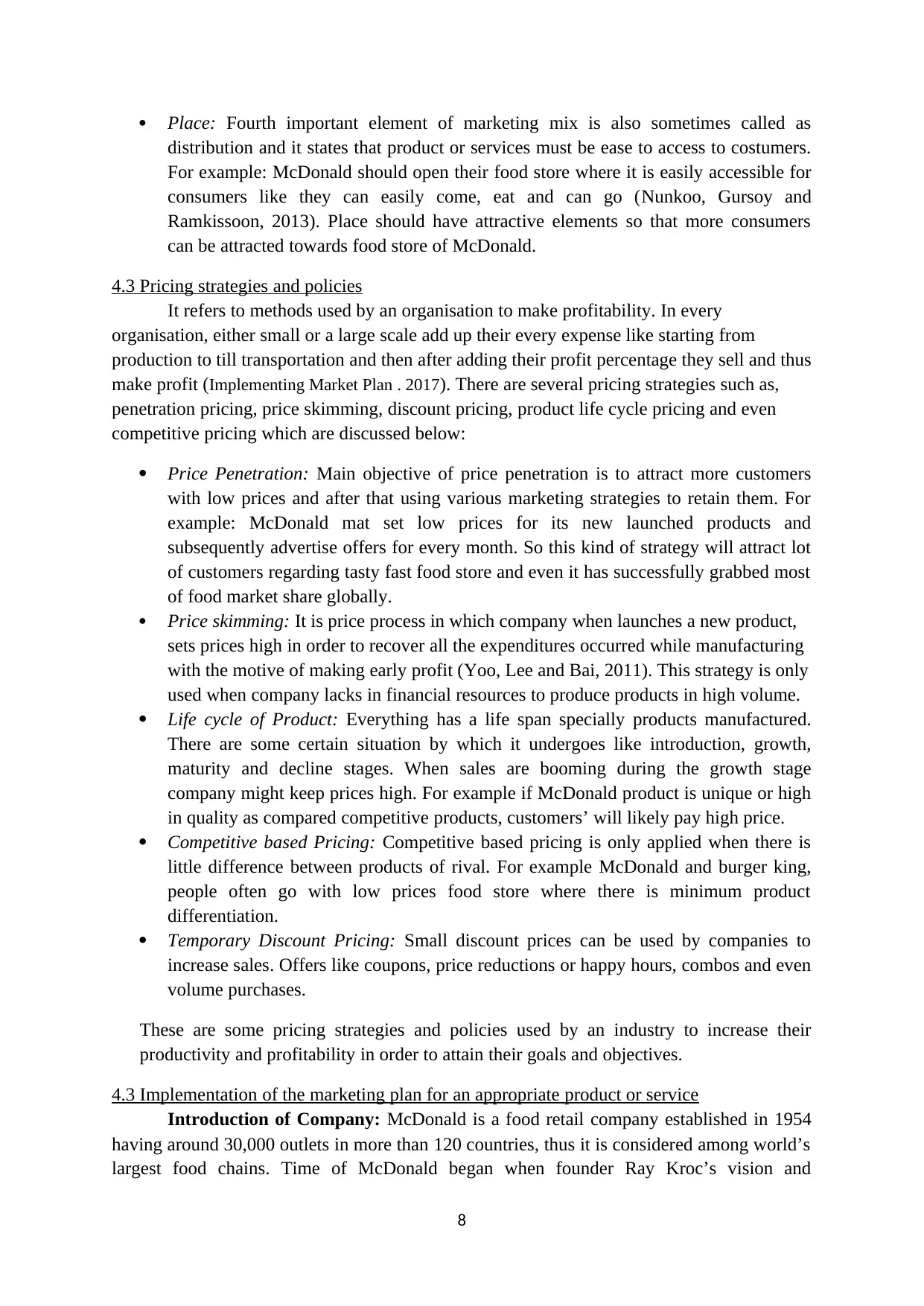
Place: Fourth important element of marketing mix is also sometimes called as
distribution and it states that product or services must be ease to access to costumers.
For example: McDonald should open their food store where it is easily accessible for
consumers like they can easily come, eat and can go (Nunkoo, Gursoy and
Ramkissoon, 2013). Place should have attractive elements so that more consumers
can be attracted towards food store of McDonald.
4.3 Pricing strategies and policies
It refers to methods used by an organisation to make profitability. In every
organisation, either small or a large scale add up their every expense like starting from
production to till transportation and then after adding their profit percentage they sell and thus
make profit (Implementing Market Plan . 2017). There are several pricing strategies such as,
penetration pricing, price skimming, discount pricing, product life cycle pricing and even
competitive pricing which are discussed below:
Price Penetration: Main objective of price penetration is to attract more customers
with low prices and after that using various marketing strategies to retain them. For
example: McDonald mat set low prices for its new launched products and
subsequently advertise offers for every month. So this kind of strategy will attract lot
of customers regarding tasty fast food store and even it has successfully grabbed most
of food market share globally.
Price skimming: It is price process in which company when launches a new product,
sets prices high in order to recover all the expenditures occurred while manufacturing
with the motive of making early profit (Yoo, Lee and Bai, 2011). This strategy is only
used when company lacks in financial resources to produce products in high volume.
Life cycle of Product: Everything has a life span specially products manufactured.
There are some certain situation by which it undergoes like introduction, growth,
maturity and decline stages. When sales are booming during the growth stage
company might keep prices high. For example if McDonald product is unique or high
in quality as compared competitive products, customers’ will likely pay high price.
Competitive based Pricing: Competitive based pricing is only applied when there is
little difference between products of rival. For example McDonald and burger king,
people often go with low prices food store where there is minimum product
differentiation.
Temporary Discount Pricing: Small discount prices can be used by companies to
increase sales. Offers like coupons, price reductions or happy hours, combos and even
volume purchases.
These are some pricing strategies and policies used by an industry to increase their
productivity and profitability in order to attain their goals and objectives.
4.3 Implementation of the marketing plan for an appropriate product or service
Introduction of Company: McDonald is a food retail company established in 1954
having around 30,000 outlets in more than 120 countries, thus it is considered among world’s
largest food chains. Time of McDonald began when founder Ray Kroc’s vision and
8
distribution and it states that product or services must be ease to access to costumers.
For example: McDonald should open their food store where it is easily accessible for
consumers like they can easily come, eat and can go (Nunkoo, Gursoy and
Ramkissoon, 2013). Place should have attractive elements so that more consumers
can be attracted towards food store of McDonald.
4.3 Pricing strategies and policies
It refers to methods used by an organisation to make profitability. In every
organisation, either small or a large scale add up their every expense like starting from
production to till transportation and then after adding their profit percentage they sell and thus
make profit (Implementing Market Plan . 2017). There are several pricing strategies such as,
penetration pricing, price skimming, discount pricing, product life cycle pricing and even
competitive pricing which are discussed below:
Price Penetration: Main objective of price penetration is to attract more customers
with low prices and after that using various marketing strategies to retain them. For
example: McDonald mat set low prices for its new launched products and
subsequently advertise offers for every month. So this kind of strategy will attract lot
of customers regarding tasty fast food store and even it has successfully grabbed most
of food market share globally.
Price skimming: It is price process in which company when launches a new product,
sets prices high in order to recover all the expenditures occurred while manufacturing
with the motive of making early profit (Yoo, Lee and Bai, 2011). This strategy is only
used when company lacks in financial resources to produce products in high volume.
Life cycle of Product: Everything has a life span specially products manufactured.
There are some certain situation by which it undergoes like introduction, growth,
maturity and decline stages. When sales are booming during the growth stage
company might keep prices high. For example if McDonald product is unique or high
in quality as compared competitive products, customers’ will likely pay high price.
Competitive based Pricing: Competitive based pricing is only applied when there is
little difference between products of rival. For example McDonald and burger king,
people often go with low prices food store where there is minimum product
differentiation.
Temporary Discount Pricing: Small discount prices can be used by companies to
increase sales. Offers like coupons, price reductions or happy hours, combos and even
volume purchases.
These are some pricing strategies and policies used by an industry to increase their
productivity and profitability in order to attain their goals and objectives.
4.3 Implementation of the marketing plan for an appropriate product or service
Introduction of Company: McDonald is a food retail company established in 1954
having around 30,000 outlets in more than 120 countries, thus it is considered among world’s
largest food chains. Time of McDonald began when founder Ray Kroc’s vision and
8

dedication along with his brilliant strategies showed colours and polished the name of
McDonald’s.
Mission and Vision: To be customer’s favourite place and when they eat they feel delighted
with unmatched quality, services, and cleanliness. Their main objective is to get attached with
more customers and satisfy them with quality fast food products and its taste (Line and
Runyan, 2012). Vision is to be best quick service restaurant in world along with their core
values and guiding principles. McDonald believes that customer perception is one thing
which always guarantee product services.
SWOT Analysis:
Strengths
It has global presence with huge
impact on competitors.
Market leader in international as well
as domestic markets.
They are capable of generating
revenues and sales due to its brand
recognisation.
Weaknesses
Saturation of market has made
expansion difficult for Macdonald.
It is very slow in terms of product
innovation.
Opportunities
Outlet chains can be developed and
can be made more attractive like by
providing internet access.
International expansion is still an
opportunity for McDonald.
Product innovation is another
opportunity which can be grabbed by
them.
Threats
McDonald’s violent growth has made
it defenceless for other countries
economic slowdown.
Fluctuations in foreign currency can
affect their business process in
negative manner.
Big companies like Yum! , burger king corporation, KFC and dominos are serving as major
competitors.
Target market: They have been using demographic segmentation strategy which means
segmenting customers according gender, age, income, education, ethnic background etc.
Their major target segments are children, youth, and young urban family members.
Budget: Huge expenses are required by marketing strategy to support marketing budgets. In
McDonald’s budgets are allocated after analysing strategies like market penetration, market
development, and service development. In this way marketing budgets are allocated (Leung,
Law Van Hoof and Buhalis, 2013). Certain percentage of budget has been allocated to
marketing department like almost 50% of total budget of company but this can change due to
seasonal change or launching of new products.
9
McDonald’s.
Mission and Vision: To be customer’s favourite place and when they eat they feel delighted
with unmatched quality, services, and cleanliness. Their main objective is to get attached with
more customers and satisfy them with quality fast food products and its taste (Line and
Runyan, 2012). Vision is to be best quick service restaurant in world along with their core
values and guiding principles. McDonald believes that customer perception is one thing
which always guarantee product services.
SWOT Analysis:
Strengths
It has global presence with huge
impact on competitors.
Market leader in international as well
as domestic markets.
They are capable of generating
revenues and sales due to its brand
recognisation.
Weaknesses
Saturation of market has made
expansion difficult for Macdonald.
It is very slow in terms of product
innovation.
Opportunities
Outlet chains can be developed and
can be made more attractive like by
providing internet access.
International expansion is still an
opportunity for McDonald.
Product innovation is another
opportunity which can be grabbed by
them.
Threats
McDonald’s violent growth has made
it defenceless for other countries
economic slowdown.
Fluctuations in foreign currency can
affect their business process in
negative manner.
Big companies like Yum! , burger king corporation, KFC and dominos are serving as major
competitors.
Target market: They have been using demographic segmentation strategy which means
segmenting customers according gender, age, income, education, ethnic background etc.
Their major target segments are children, youth, and young urban family members.
Budget: Huge expenses are required by marketing strategy to support marketing budgets. In
McDonald’s budgets are allocated after analysing strategies like market penetration, market
development, and service development. In this way marketing budgets are allocated (Leung,
Law Van Hoof and Buhalis, 2013). Certain percentage of budget has been allocated to
marketing department like almost 50% of total budget of company but this can change due to
seasonal change or launching of new products.
9
⊘ This is a preview!⊘
Do you want full access?
Subscribe today to unlock all pages.

Trusted by 1+ million students worldwide
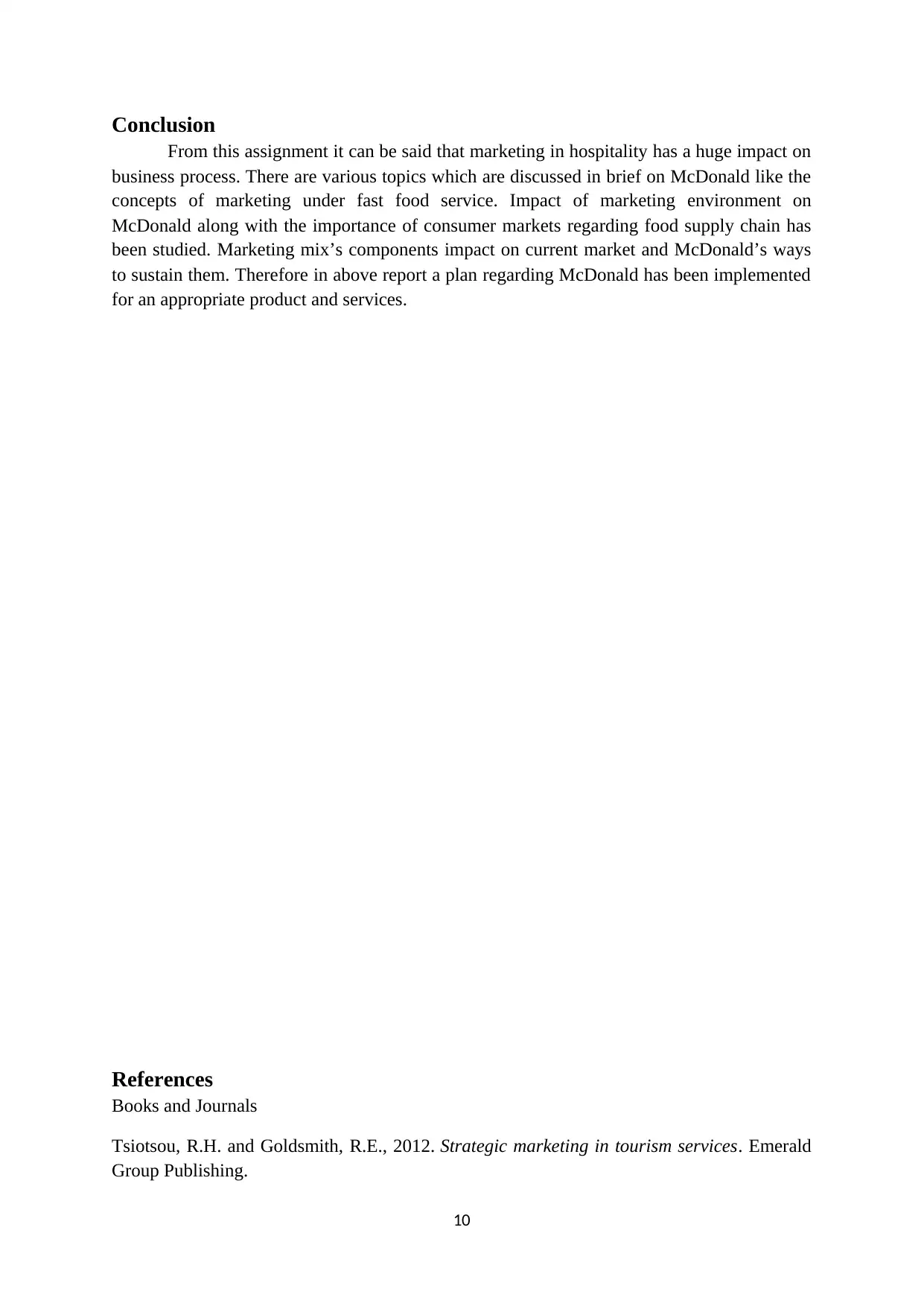
Conclusion
From this assignment it can be said that marketing in hospitality has a huge impact on
business process. There are various topics which are discussed in brief on McDonald like the
concepts of marketing under fast food service. Impact of marketing environment on
McDonald along with the importance of consumer markets regarding food supply chain has
been studied. Marketing mix’s components impact on current market and McDonald’s ways
to sustain them. Therefore in above report a plan regarding McDonald has been implemented
for an appropriate product and services.
References
Books and Journals
Tsiotsou, R.H. and Goldsmith, R.E., 2012. Strategic marketing in tourism services. Emerald
Group Publishing.
10
From this assignment it can be said that marketing in hospitality has a huge impact on
business process. There are various topics which are discussed in brief on McDonald like the
concepts of marketing under fast food service. Impact of marketing environment on
McDonald along with the importance of consumer markets regarding food supply chain has
been studied. Marketing mix’s components impact on current market and McDonald’s ways
to sustain them. Therefore in above report a plan regarding McDonald has been implemented
for an appropriate product and services.
References
Books and Journals
Tsiotsou, R.H. and Goldsmith, R.E., 2012. Strategic marketing in tourism services. Emerald
Group Publishing.
10
Paraphrase This Document
Need a fresh take? Get an instant paraphrase of this document with our AI Paraphraser
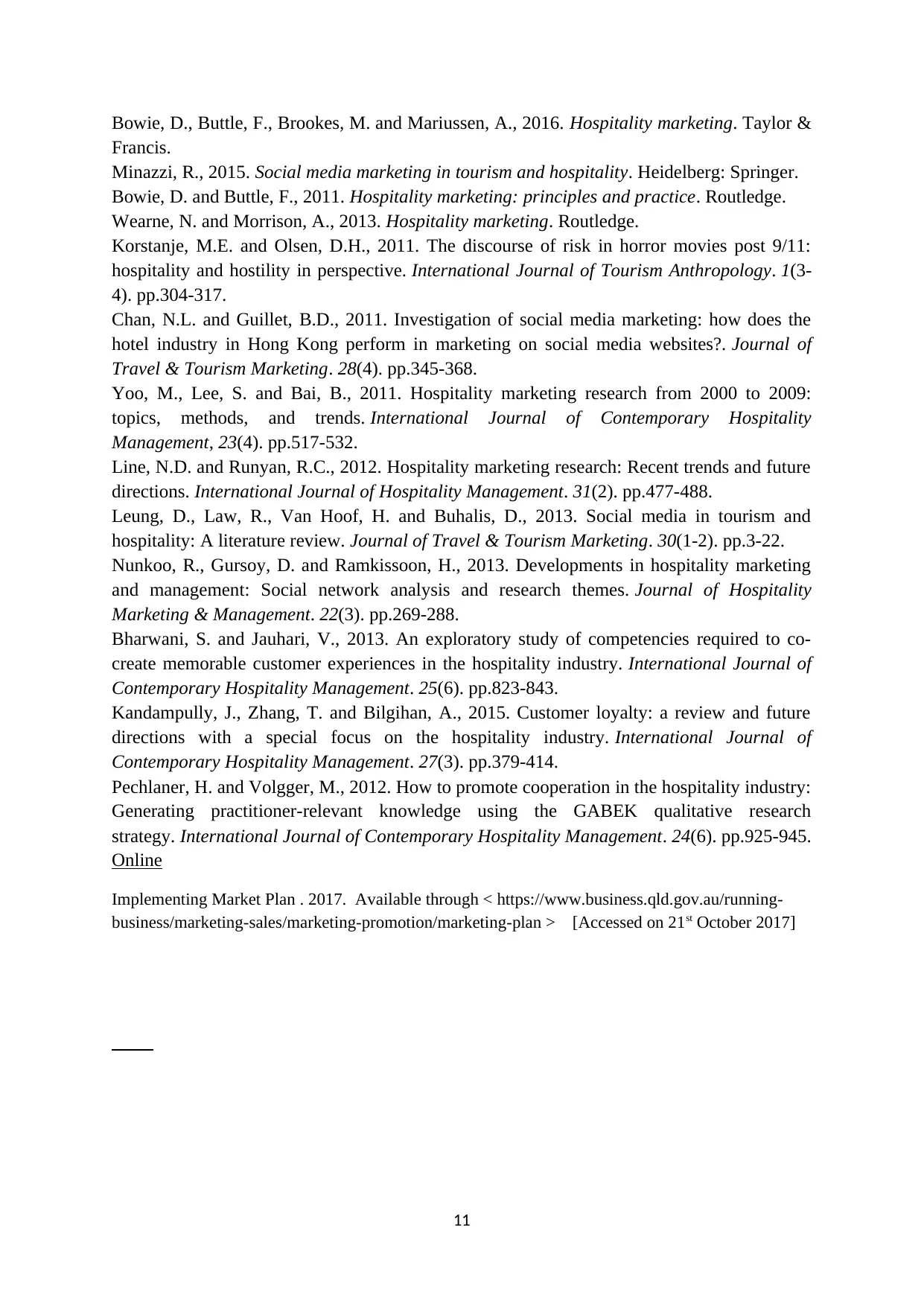
Bowie, D., Buttle, F., Brookes, M. and Mariussen, A., 2016. Hospitality marketing. Taylor &
Francis.
Minazzi, R., 2015. Social media marketing in tourism and hospitality. Heidelberg: Springer.
Bowie, D. and Buttle, F., 2011. Hospitality marketing: principles and practice. Routledge.
Wearne, N. and Morrison, A., 2013. Hospitality marketing. Routledge.
Korstanje, M.E. and Olsen, D.H., 2011. The discourse of risk in horror movies post 9/11:
hospitality and hostility in perspective. International Journal of Tourism Anthropology. 1(3-
4). pp.304-317.
Chan, N.L. and Guillet, B.D., 2011. Investigation of social media marketing: how does the
hotel industry in Hong Kong perform in marketing on social media websites?. Journal of
Travel & Tourism Marketing. 28(4). pp.345-368.
Yoo, M., Lee, S. and Bai, B., 2011. Hospitality marketing research from 2000 to 2009:
topics, methods, and trends. International Journal of Contemporary Hospitality
Management, 23(4). pp.517-532.
Line, N.D. and Runyan, R.C., 2012. Hospitality marketing research: Recent trends and future
directions. International Journal of Hospitality Management. 31(2). pp.477-488.
Leung, D., Law, R., Van Hoof, H. and Buhalis, D., 2013. Social media in tourism and
hospitality: A literature review. Journal of Travel & Tourism Marketing. 30(1-2). pp.3-22.
Nunkoo, R., Gursoy, D. and Ramkissoon, H., 2013. Developments in hospitality marketing
and management: Social network analysis and research themes. Journal of Hospitality
Marketing & Management. 22(3). pp.269-288.
Bharwani, S. and Jauhari, V., 2013. An exploratory study of competencies required to co-
create memorable customer experiences in the hospitality industry. International Journal of
Contemporary Hospitality Management. 25(6). pp.823-843.
Kandampully, J., Zhang, T. and Bilgihan, A., 2015. Customer loyalty: a review and future
directions with a special focus on the hospitality industry. International Journal of
Contemporary Hospitality Management. 27(3). pp.379-414.
Pechlaner, H. and Volgger, M., 2012. How to promote cooperation in the hospitality industry:
Generating practitioner-relevant knowledge using the GABEK qualitative research
strategy. International Journal of Contemporary Hospitality Management. 24(6). pp.925-945.
Online
Implementing Market Plan . 2017. Available through < https://www.business.qld.gov.au/running-
business/marketing-sales/marketing-promotion/marketing-plan > [Accessed on 21st October 2017]
11
Francis.
Minazzi, R., 2015. Social media marketing in tourism and hospitality. Heidelberg: Springer.
Bowie, D. and Buttle, F., 2011. Hospitality marketing: principles and practice. Routledge.
Wearne, N. and Morrison, A., 2013. Hospitality marketing. Routledge.
Korstanje, M.E. and Olsen, D.H., 2011. The discourse of risk in horror movies post 9/11:
hospitality and hostility in perspective. International Journal of Tourism Anthropology. 1(3-
4). pp.304-317.
Chan, N.L. and Guillet, B.D., 2011. Investigation of social media marketing: how does the
hotel industry in Hong Kong perform in marketing on social media websites?. Journal of
Travel & Tourism Marketing. 28(4). pp.345-368.
Yoo, M., Lee, S. and Bai, B., 2011. Hospitality marketing research from 2000 to 2009:
topics, methods, and trends. International Journal of Contemporary Hospitality
Management, 23(4). pp.517-532.
Line, N.D. and Runyan, R.C., 2012. Hospitality marketing research: Recent trends and future
directions. International Journal of Hospitality Management. 31(2). pp.477-488.
Leung, D., Law, R., Van Hoof, H. and Buhalis, D., 2013. Social media in tourism and
hospitality: A literature review. Journal of Travel & Tourism Marketing. 30(1-2). pp.3-22.
Nunkoo, R., Gursoy, D. and Ramkissoon, H., 2013. Developments in hospitality marketing
and management: Social network analysis and research themes. Journal of Hospitality
Marketing & Management. 22(3). pp.269-288.
Bharwani, S. and Jauhari, V., 2013. An exploratory study of competencies required to co-
create memorable customer experiences in the hospitality industry. International Journal of
Contemporary Hospitality Management. 25(6). pp.823-843.
Kandampully, J., Zhang, T. and Bilgihan, A., 2015. Customer loyalty: a review and future
directions with a special focus on the hospitality industry. International Journal of
Contemporary Hospitality Management. 27(3). pp.379-414.
Pechlaner, H. and Volgger, M., 2012. How to promote cooperation in the hospitality industry:
Generating practitioner-relevant knowledge using the GABEK qualitative research
strategy. International Journal of Contemporary Hospitality Management. 24(6). pp.925-945.
Online
Implementing Market Plan . 2017. Available through < https://www.business.qld.gov.au/running-
business/marketing-sales/marketing-promotion/marketing-plan > [Accessed on 21st October 2017]
11

12
⊘ This is a preview!⊘
Do you want full access?
Subscribe today to unlock all pages.

Trusted by 1+ million students worldwide
1 out of 12
Related Documents
Your All-in-One AI-Powered Toolkit for Academic Success.
+13062052269
info@desklib.com
Available 24*7 on WhatsApp / Email
![[object Object]](/_next/static/media/star-bottom.7253800d.svg)
Unlock your academic potential
Copyright © 2020–2025 A2Z Services. All Rights Reserved. Developed and managed by ZUCOL.





